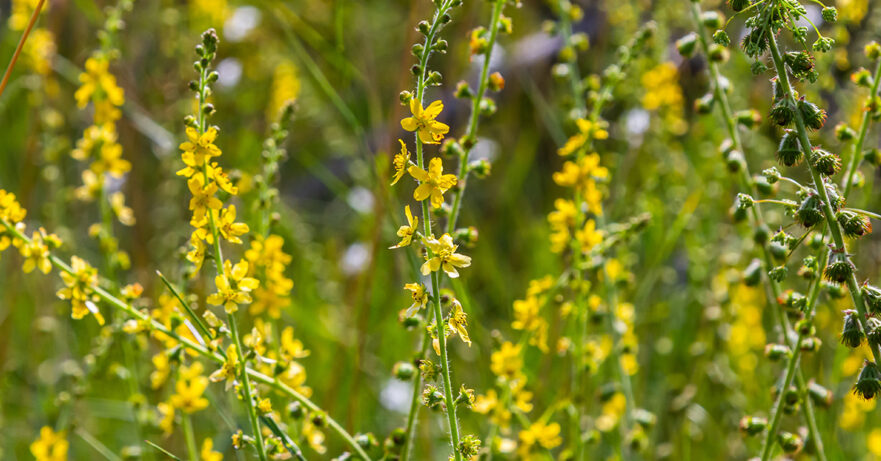In this monograph about agrimony:
📖 Introduction | 🌱 Botanical Description | 📜 Traditional Uses | 🔍 Phytochemistry | ✨ Applications and Uses | 🛡️ Safety Profile
📖 Introduction
Agrimony (Agrimonia eupatoria) is a perennial herb belonging to the Rosaceae family. It has a long history in herbal medicine for its astringent and healing properties. Traditionally, it has been used across various cultures to address skin, digestive, and respiratory conditions.
| English Name | Agrimony |
| Latin Name | Agrimonia eupatoria |
| Parts Used | Aerial parts |
| Traditional Uses | Mild sore throat, diarrhea |
| Herbal Actions | Astringent, diuretic, tonic, hepatic |
🌱 Botanical Description
Scientific Classification
Falls within the Rosaceae family.
Physical Characteristics
It features tall, erect stems with serrated leaves and bears small yellow flowers.
Natural Habitat and Cultivation Details
Native to the temperate regions of the Northern Hemisphere, agrimony thrives in well-drained soil, under full sun to partial shade.
📜 Traditional Uses
Historically utilized for its astringent properties, agrimony has been applied to wounds and used to treat sore throats, diarrhea, and digestive issues. Its role in folklore emphasizes its use as a remedy for skin ailments and a protective herb in various cultures.

🔍 Phytochemistry (Active Constituents)
Agrimony is rich in:
- Tannins: Responsible for its astringent properties, which are beneficial for skin and mucous membranes.
- Flavonoids: Contribute to its anti-inflammatory and antioxidant effects.
- Coumarins: These compounds may possess mild blood-thinning properties but should be used with caution in individuals on anticoagulant therapy.
- Volatile oils: These contribute to the herb’s therapeutic aroma and may support potential antimicrobial action, although more research is needed to understand the extent of these antimicrobial properties fully.
✨ Applications and Uses
In herbal medicine, agrimony is appreciated for its:
- Gastrointestinal support: Helps to soothe the digestive tract and manage mild diarrheal conditions through its astringent properties. However, individuals with ongoing or severe gastrointestinal issues need to seek advice from a healthcare professional.
- Skin health: It is applied topically in poultices or infusions for its healing effects on minor wounds and irritations. Its astringent and antimicrobial properties may contribute to these effects, although ensuring clean, sterile methods for preparation and application is crucial to avoid infection.
- Respiratory relief: It is used in teas or gargles to alleviate throat discomfort, with its astringent properties possibly helping to soothe the throat. However, consulting a healthcare provider is recommended for persistent or severe throat issues.
The combination of tannins, flavonoids, and other compounds supports the traditional applications of agrimony, providing a multifaceted approach to wellness. Nonetheless, scientific research to fully substantiate these uses is ongoing, and individuals should consider both traditional knowledge and current scientific understanding when using agrimony for medicinal purposes.
🛡️ Safety Profile
Agrimony is generally safe for most individuals when consumed in moderation.
However, due to its tannin content, prolonged use should be approached with caution to avoid potential gastrointestinal discomfort.
Those with bleeding disorders or on anticoagulant therapy should consult a healthcare provider due to its potential coumarin content.
As with all herbs, individuals who are pregnant, breastfeeding, or with specific health conditions should seek medical advice before use.
📃 Related Posts

